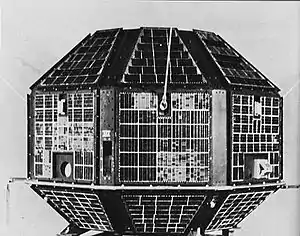| Mission type | Lunar sample return |
|---|---|
| Operator | ISRO |
| Spacecraft properties | |
| Bus | Chandrayaan |
| Manufacturer | ISRO |
| Start of mission | |
| Launch date | ≥ 2028[1] |
| Rocket | |
| Launch site | Satish Dhawan Space Centre |
| Contractor | ISRO |
Chandrayaan-4 is a planned lunar sample-return mission of the Indian Space Research Organisation (ISRO) and will be the fourth mission in its Chandrayaan programme. It consists of four modules namely Transfer module (TM), Lander module (LM), Ascender module (AM) and Reentry Module (RM). The planned mission life is 1 lunar day, and the landing site is near to Shiv Shakti Point, the landing site of Chandrayaan-3's Lander.[2][3]
History
On 17 November 2023, the plan for a lunar sample return mission was revealed by Nilesh M. Desai, Director of the Space Applications Centre (SAC) during the 62nd foundation day ceremony of the Indian Institute of Tropical Meteorology (IITM) in Pune. He said that it is a very ambitious mission and hopefully in next five to seven years we will meet this challenge of bringing sample from the surface of the Moon.[4][5]
On 4 September 2023, the Vikram Lander of Chandrayaan-3 restarted its engines to showcase technologies for a future lunar sample-return mission. It rose to a height of about 40 centimeters above the surface and then landed 30 to 40 centimeters distant from its initial landing point.[6]
Upon determining that the Chandrayaan-3 propulsion module still had more than 100 kg of propellant left, ISRO decided to attempt a return to Earth orbit in order to further test the technologies for lunar sample-return mission. On 9 October 2023, the first maneuver was executed, increasing the apolune from 150 to 5,112 km. On 13 October 2023, the module executed a trans-earth injection maneuver, setting it on a course that would see it make four near-misses with the moon before departing its orbit on 10 November 2023. After entering a high orbit around the Earth, the spacecraft reached its first perigee on 22 November 2023, at a height of 154,000 km. On 4 December 2023, ISRO declared that following a series of maneuvers, the propulsion module is now in a high orbit around the Earth.[7]
Description
The Transfer Module - Reentry Module (TM+RM) composite launched onboard a GSLV rocket which will after a series of orbit manuvering will be parked on a favourable lunar orbit for Ascender Module docking. Lander Module cum Ascender Module (LM+AM) structure launched onboard LVM3 rocket will make a descent to the landing site. The robotic arm mechanism in Lander Module will collect samples and transfer it to the Ascender Module which will separate from LM and make a lift off from lunar surface to dock with the Transfer Module of TM+RM composite in lunar orbit. Transfer Module will transfer the samples to Reentry Module and Ascender Module will undock from the thus formed tri-module structure. TM+RM composite will make a return flight to Earth's orbit after which on separation, the Reentry Module to make a re-entry to the Earth's surface with the samples.[8][9][10][11]
Mission components
Lunar lander will land on the Moon with instrumentation. It supports the ascend stage along with the soil sampling instrumentation.
Lunar module ascender will launch from the Moon, using the lander as a launch pad and enter lunar orbit.
Transfer module will collect the samples from the ascend stage, transfer them to the reentry module, fire its engine to set both modules towards Earth, release the payload, and loop back around the Earth.
Reentry module will hold the sample from lunar orbit. It is designed to survive atmospheric reentry and land with the lunar regoliths.
Mission strategy
The Chandrayaan-4 mission will be executed in two phases. The first phase will involve the launch of a lander and an "ascender" module to gather samples from the Moon's surface. This crucial step is expected to take place near the lunar south pole, an area of great interest due to its abundance of water ice, which holds potential for rocket fuel and life support.[12]
Once the samples are collected, the spacecraft will connect to another module in space. As the two modules approach Earth, they will split into two parts: one will return to Earth while the other continues to orbit it. This intricate process necessitates the use of two powerful rockets to safely return the lunar samples.[13]
See also
References
- ↑ IITM Foundation Day 17th Nov 2023, retrieved 2023-11-20
- ↑ IITM Foundation Day 17th Nov 2023, retrieved 2023-11-20
- 1 2 "ISRO working on ambitious lunar missions LUPEX, Chandrayaan-4: Official". The Economic Times. 2023-11-17. ISSN 0013-0389. Retrieved 2023-11-20.
- ↑ "ISRO working on ambitious lunar missions LUPEX, Chandrayaan-4: Official". The Economic Times. 2023-11-17. ISSN 0013-0389. Retrieved 2023-11-20.
- ↑ "Chandrayaan-4: ISRO's Ambitious Mission To Bring Back Soil Samples From Moon". Free Press Journal. Retrieved 2023-11-20.
- ↑ "Chandrayaan-3 | Vikram hops on the Moon and lands safely". The Hindu. 2023-09-04. ISSN 0971-751X. Retrieved 2024-01-03.
- ↑ Foust, Jeff (2023-12-05). "India returns Chandrayaan-3 propulsion module to Earth orbit". SpaceNews. Retrieved 2024-01-03.
- ↑ IITM Foundation Day 17th Nov 2023, retrieved 2023-11-20
- ↑ "ISRO working on ambitious lunar missions LUPEX, Chandrayaan-4: Official". Breaking news, top new, latest news, world news | Indian Economic Observer. Retrieved 2023-11-20.
- ↑ Livemint (2023-11-19). "Chandrayaan-4: ISRO to bring back soil samples from the Moon". mint. Retrieved 2023-11-20.
- ↑ https://twitter.com/TitaniumSV5/status/1725877570393264420?t=0wQzlRwh3VpAGVOEyj9C5g&s=19
- ↑ "After Chandrayaan-3's success, ISRO prepares for Chandrayaan-4 lunar mission: All about it". The Times of India. ISSN 0971-8257. Retrieved 2023-12-07.
- ↑ IAS, Top IAS Coaching in Delhi-SHRI RAM. "Chandrayaan-4: India's Next Lunar Mission Marks a Giant Leap in Space Exploration | Best IAS Coaching in Delhi, India - SHRI RAM IAS". web.shriramias.in. Retrieved 2023-12-07.

